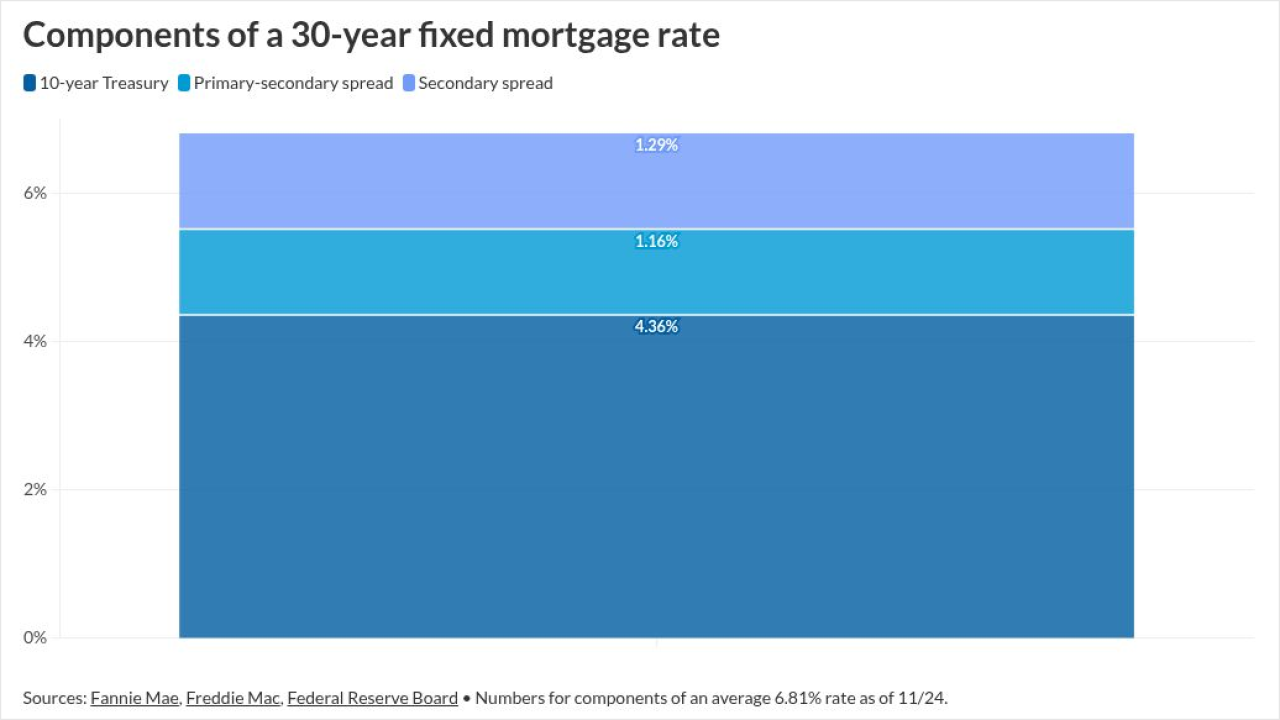Nonbanks looking to expand in multifamily lending have found a new source of funding in an esoteric (and somewhat tarnished) corner of the mortgage bond market.
Many of these lenders originate large volumes of multifamily loans for the Federal Housing Administration, Freddie Mac and Fannie Mae. They also specialize in what is known as “transitional” lending, or short-term, floating-rate loans on commercial property buildings that are being repurposed or fixed up in order to eventually qualify for cheaper, longer-term financing.
The transitional loans — also known as bridge loans — have traditionally been kept on balance sheet. But with interest rates headed higher and the multifamily market still going strong, it has become attractive to bundle these loans into collateral for transactions called commercial real estate collateralized loan obligations (CRE CLOs).
The funding is longer-term and less expensive than other sources of capital, such as bank lines of credit, putting nonbanks in a stronger competitive position.
“To some extent, this demand [for bridge financing] is increasing as commercial banks continue to reduce their lending,” said Jeffrey Baevsky, a senior managing director in charge of structured finance at Greystone, which issued its first CRE CLO, and the first such deal of the year, in March. “We’re taking business away.”
The CRE CLO market is pretty small. In 2015, 13 deals produced $5.5 billion of issuance, and last year there were just nine deals worth $2.7 billion, according to the credit rating agency DBRS. But this year, things are picking up again, in part due to new entrants such as Greystone that are focused on the multifamily market. As of mid-2017 it was at $2.5 billion, and there were at least five deals in the pipeline for the third quarter.
While the multifamily market has soft spots, demand for rental housing is still strong, particularly for affordable rental housing. Freddie Mac is predicting that origination volume is likely to hit another record in 2017, reaching between $270 and $280 billion.
And there is some thought that heavy construction of high-end apartments is putting pressure on landlords to spiff up older properties, according to Erin Stafford, a managing director at DBRS.
Stafford said that CRE CLOs finance reinvestment in properties to ensure they remain competitive and continue to get market, or closer to market, rents — and potentially qualify for government-sponsored-enterprise financing. “There’s a lot of new product coming online that is Class A, whereas CRE CLO transitions typically finance more workforce housing, Class C and B,” she said.

Baevsky said Greystone’s transitional lending falls into two categories. The first is financing that just buys time, such as placeholder financing for 12-18 months while a financing application with the Department of Housing and Urban Development is in the works.
At the other extreme are property buyers who want to do “light capex” such as kitchen or bath remodeling or painting “to boost operating cash flow before seeking permanent financing” to take a property from C+ to B status, he said.
“We see a tremendous amount of opportunity and product flow at that end of the spectrum,” Baevsky said.
Greystone, based in New York, has approximately $1 billion in transitional finance or bridge loans on its books today; the average loan is only $13 million.
Hunt Mortgage Group, a nonbank lender that originates some $2 billion in multifamily loans a year for the GSEs, also launched its first CRE CLO in July. The $280 million transaction is backed by 23 loans on 36 properties. The largest is a $33.8 million mortgage on a portfolio of five apartment buildings in Abilene, Texas. The owner is in the process of making improvements to the units, including repainted cabinets and countertops, installing appliance packages and upgrading floors.
Unlike Greystone’s deal, Hunt’s is not backed exclusively by multifamily loans. There are four, representing 12.2% of the initial pool balance, that are secured by commercial and specialty properties, according to DBRS. The rating agency cites those as potential credit risks, since these two property types “often exhibit higher cash flow volatility than traditional multifamily properties.”
Hunt’s deal and Greystone’s share the same placement agents, Wells Fargo Securities and JPMorgan Securities — suggesting that the banks themselves are playing a role in expanding the market for CRE CLOs.
Other deals issued this year have come from repeat issuers and had a broader mix of collateral, including not just apartments, but hotels and office buildings, retail and even industrial properties.
CRE CLOs appeal to investors now because the securities that they issue pay floating rates of interest and are relatively short-term. These securities typically have initial terms of two or three years and can be extended several times for a total term of four or five years. By comparison, more typical commercial mortgage bonds pay fixed rates of interest and have terms of seven to 10 years.
But the market is still somewhat tarnished by the poor performance of pre-crisis deals, which were called CRE CDOs and included some much more problematic collateral.
However, Rick Jones, a finance and real estate partner at the law firm Dechert, said that both the terms and structure of the newer deals have changed from those issued from 2003 to 2006.
“Back in the day, there were two things that characterized deals,” Jones said. “One, in hindsight was an awful idea; the other was maybe tarred by the same brush. The awful idea was that the transaction could include buckets for all sorts of bits and pieces,” such as subordinate notes and synthetic securities.
“No one understood them, the rating agencies didn’t appreciate the risk,” he said. “That feature is truly dead and buried.”
The other thing that characterized pre-crisis CRE CLOs was the fact that they were actively managed, meaning principal proceeds that were repaid could be used to make fresh loans. “That’s a feature that’s going to end up back in the space, but we haven’t really gotten there yet,” Jones said.
Some of the first deals issued after the financial crisis were backed by nonperforming loans that were in the process of being liquidated. “That was fun for a while,” Jones said. “It’s gone away.”
Now, he said, the core of the market is bridge loans for properties in transition.
Recent transactions included some features that suggest investors are becoming more comfortable with this corner of the structured finance market. One of those is a limited reinvestment period. Both Greystone’s CLO and Hunt’s allowed for new loans to be acquired for a limited period (180 days in Hunt’s case).
Another CRE CLO, issued by Benefit Street Partners in June, was the first since the financial crisis with multiple property types that has a reinvestment period of one year, according to DBRS. Another CLO completed in June by RAIT Financial Trust has a ramp-up period allowing the real estate investment trust to acquire some of the initial collateral up to 90 days after the close of the transaction.
“One of things every investor we met with asked was why the deal was going to be actively managed,” Greystone’s Baevsky said. “The simple answer was that not every loan was originated last month; some were originated two years ago. They’ll get repaid at a variety of maturity dates, so the CLO had to be actively managed.”




